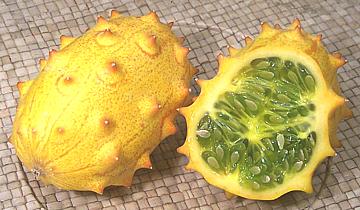 [PLU #4302, Horned Melon, Melano, Horned Cucumber, Jelly melon, English
tomato, Metulon (France), Cucumis metuliferus]
[PLU #4302, Horned Melon, Melano, Horned Cucumber, Jelly melon, English
tomato, Metulon (France), Cucumis metuliferus]
This odd African melon is grown in the Kenya, Israel, New Zealand and the U.S. as a decorative fruit and in Australia as a noxious weed. Now grown commercially in California they have a long shelf life and are easily shipped so you will find a few in supermarkets but often at prices that will leave you gasping. The photo specimen was 4-3/4 inches long, 2.8 inches diameter and weighed 11-3/4 ounces, from a small chain supermarket for $2.99 each or $4.07 / pound. Major supermarkets may charge as much as $4.99 per melon.
They are sold mainly as a curiosity and are not expected to be a viable food crop until varieties with a higher sugar content are developed. Currently they have a light refreshing flavor but are not real sweet. It's the seed mass you eat as there is very little edible flesh inside the hard rind. Note: seed merchants are also selling purely decorative varieties which look about the same but are very toxic. You won't eat those by accident because the toxin is extremely bitter.
More on Melons.
I've read some pretty absurd things about this melon, including a long wikiHow article on how to eat them without eating any of the seeds. Really dumb, because as they mention at the very bottom, the seeds are edible. This seed phobia is a hangover from Victorian times.
Another guy felt it was the most disgusting slimy fruit he had ever eaten and he could hardly finish it. What a wimp! If you get along with eating the seed mass of a fairly ripe cucumber you should have no problem with this mellon, it's very similar but with better flavor.
The seed mass is just slightly tart and has a kiwi fruit like flavor with perhaps a hint of banana. Otherwise pretty cucumber like, but jucier. There's little flesh inside the rind but what there is tastes a lot more melon like than the seed mass does. That part could use more sweetness (and to be thicker), but I get along fine with the seed mass as is - except for the price.
Suggested uses include mixing with ice cream and maybe a touch of sugar. In Africa the edible ones are eaten for the juicy seed mass and the highly toxic ones are harvested for the seeds which are non-toxic and edible.
ml_kiwanz 071026 - www.clovegarden.com